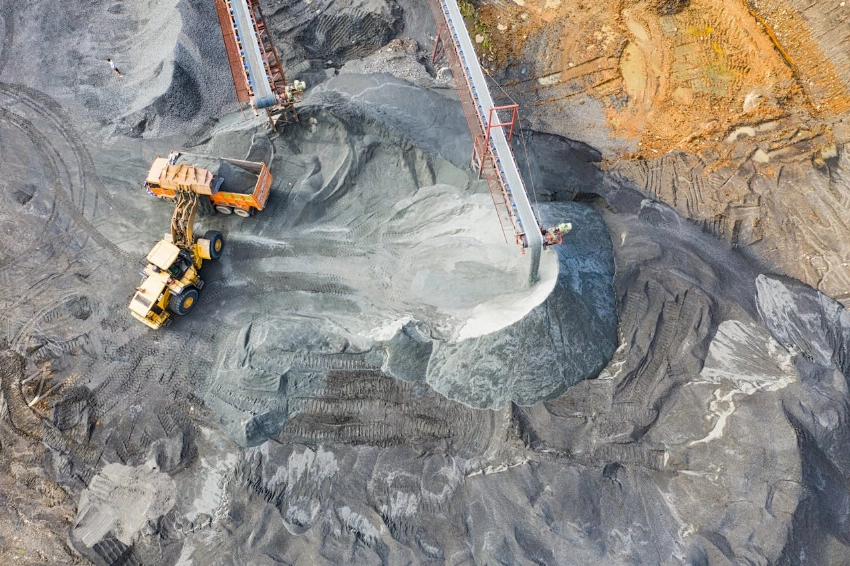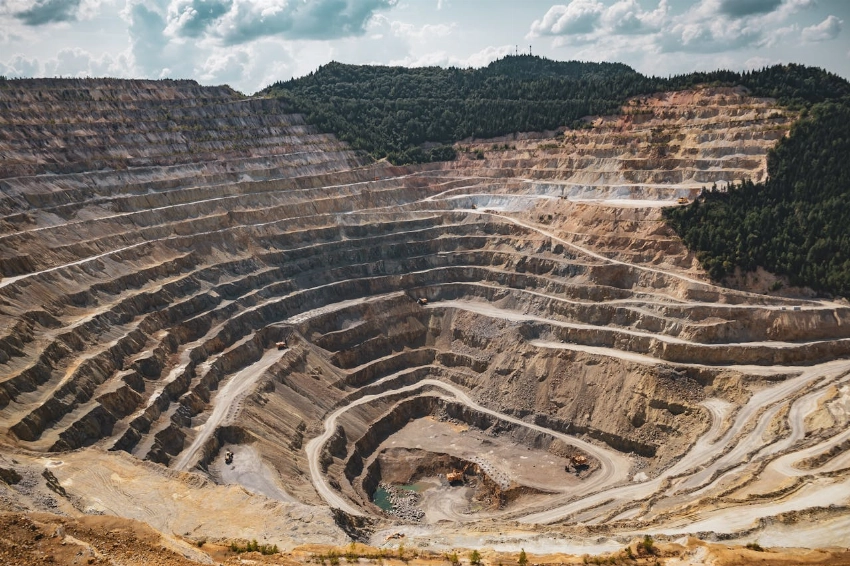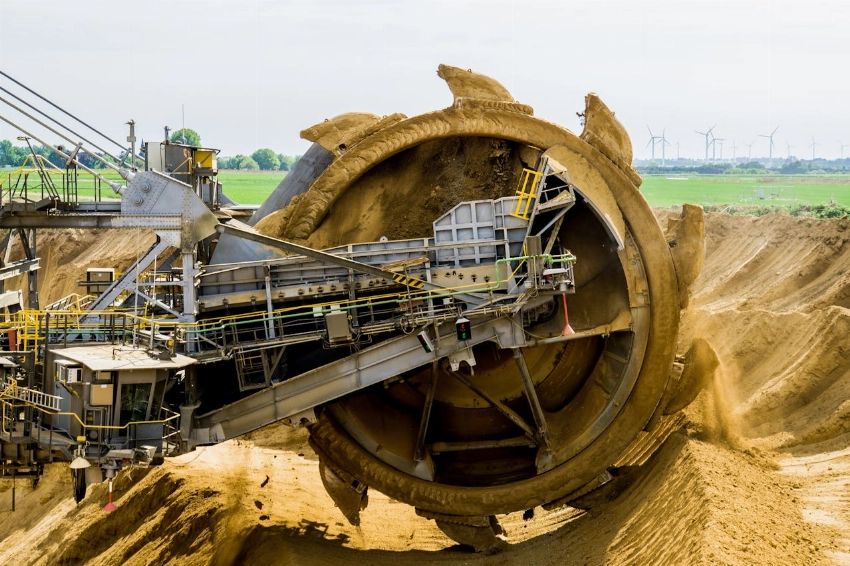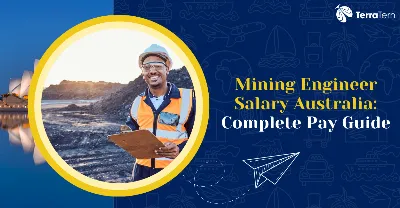Key Highlights
- What Is the Average Mining Engineer Salary in Australia in 2025?
- How Much Do Graduate Mining Engineers Earn in Australia in 2025?
- What is the Senior Mining Engineer Salary in Australia? Latest Update 2025
- How Do Mining Engineer Salaries Vary by Australian State in 2025?
- Why WA and QLD Offer Premium Rates?
- What Factors Affect Mining Engineer Salaries in Australia in 2025?
- Type of Mining and Industry Specialisation
- What Is the Complete Compensation Package for Mining Engineers Australia in 2025?
- How Can Mining Engineers Increase Their Salary in Australia?
- What Is the Job Outlook for Mining Engineers in Australia?
- How Does Australia's Mining Engineer Salary Compare Globally? Experts Insights 2025
- What Are the Typical Responsibilities of a Mining Engineer in Australia 2025?
- What Qualifications Do You Need to Become a Mining Engineer in Australia?
- What Are the Challenges and Benefits of a Mining Engineer Career in Australia in 2025?
- Conclusion
The Australian mining engineers are also among the highest-paid engineering professionals with an average annual pay of 118,000 to 163,000 Australian dollars in 2025. The average graduate mining engineer salary in Australia is around $ 91,000 -109,000 Australian dollars as an entry-level employee and 188,000-$250,000+ Australian dollars as an experienced employee. The resources sector in Australia, especially in Western Australia and Queensland, has been booming and therefore requires qualified mining engineers regularly.
The difference in salaries is based on the level of experience, the area, specialisation (coal or hard rock mining) and work options (Fly-In/Fly-Out, or FIFO, residential or not). As the mining industry continues to be the focus of the Australian economy, with expansion of 17.1 per cent in the next three years, mining engineering can attract outstanding monetary rewards and stability in a career. Let’s know more about the mining engineer salary in Australia.
|
Key Highlights |
Salary Range (Australian dollars) |
Salary Range (in INR) |
|
Average Mining Engineer Salary |
118,000 – 163,000 per year |
INR 67,54,320 – INR 93,30,120 per year |
|
Graduate Starting Salary |
91,000 – 109,000 |
INR 52,08,840 – INR 62,39,160 |
|
Senior Mining Engineer Salary |
188,000 – 250,000+ |
INR 1,07,61,120 – INR 1,43,10,000+ |
|
Highest Demand States |
Western Australia, Queensland, Northern Territory |
- |
|
Career Growth Projection |
17.1 per cent increase by 2028 |
- |
What Is the Average Mining Engineer Salary in Australia in 2025?

The average graduate mining engineer salary in Australia in 2025 sits in a strong bracket, reflecting the profession's critical role and the high demand within the resource-rich Australian economy. When looking at current market data, the average annual compensation ranges from approximately 118,000 to 163,000 Australian dollars.
Different authoritative graduate mining engineer salary Australia sources reflect this robust pay structure, but their reported figures vary based on their survey methodologies, inclusion of total compensation elements, and geographic focus.
|
Source |
Average Annual Salary (Australian dollars) |
Average Annual Salary (in INR |
|
PayScale (as of October 2025) |
118,106 |
67,60,788 |
|
Jobted (as of October 2025) |
121,400 |
69,48,936 |
|
Indeed (as of October 2025) |
163,080 |
93,34,699 |
Understanding the Total Compensation of a Mining Engineer in Australia
It is crucial to look beyond the base average mining engineer salary in Australia. The average total compensation package for a mining engineer in Australia includes several components that significantly boost the final annual earnings:
-
Base Salary: The fixed, regular income component.
-
Performance Bonuses: Can range from 5 to 20 per cent of the base average mining engineer salary in Australia, tied to individual and company performance.
-
Profit Sharing: Common at major mining companies.
-
FIFO Allowances: Significant non-taxable or concessionally taxed allowances for those working Fly-In/Fly-Out rosters.
-
Superannuation: The mandatory retirement savings contribution, currently 11.5 per cent of ordinary time earnings.
For better context, the average annual mining engineer salary in Australia equates to a monthly income of roughly 9,833 to 13,583 Australian dollars and an hourly rate ranging from approximately 60 to 80 Australian dollars, depending on the number of hours worked under typical roster patterns. This high compensation level cements mining engineering as one of the most financially rewarding careers in the nation.
Also Read: Top 10 Best Regional Areas In Australia For PR
How Much Do Graduate Mining Engineers Earn in Australia in 2025?
The starting compensation for new graduates in mining engineering is exceptionally competitive, demonstrating the industry's commitment to attracting top talent. A typical average graduate mining engineer salary in Australia ranges from 91,000 to 109,000 Australian dollars annually.
This initial mining engineer salary in Australia often surpasses starting salaries in many other engineering disciplines. The actual package can vary based on several factors:
-
Undergraduate vs. Postgraduate: Those with a Master's degree or postgraduate qualifications may start at the higher end of the range.
-
Graduate Program Structure: Large mining companies often offer structured 2 to 3-year graduate programs that include rotations, professional development, and guaranteed mining engineer salary progression.
-
Company Size: Major miners like BHP, Rio Tinto, and Fortescue typically offer the most lucrative starting packages, often including substantial sign-on bonuses.
FIFO and Graduate Packages
Many graduate roles, particularly in Western Australia and Queensland, are based on FIFO arrangements. For graduates, common roster patterns are 8 days on/6 days off or 2 weeks on/1 week off (2/1). When a graduate accepts a FIFO role, their total compensation package significantly increases due to added allowances, which can push the total package well over 120,000 Australian dollars even at the starting level. This rapid financial reward is a major draw for entry-level professionals.
|
Major Mining Company |
Typical Graduate Package Range (Australian dollars) |
Typical Graduate Package Range (in INR) |
|
BHP |
95,000 – 115,000 (Base + Super) |
54,37,800 – 65,82,600 (Base + Super) |
|
Rio Tinto |
92,000 – 110,000 (Base + Super) |
52,66,080 – 62,96,400 (Base + Super) |
|
Fortescue Metals |
90,000 – 105,000 (Base + Super) |
51,51,600 – 60,10,200 (Base + Super) |
What is the Senior Mining Engineer Salary in Australia? Latest Update 2025

Experienced professionals in the field enjoy a robust mining engineer salary Australia progression, with a senior mining engineer salary Australia exceeding 188,000 Australian dollars and reaching well over 250,000 Australian dollars for top-tier roles. Senior mining engineer salary Australia usually ranges:
|
Career Level |
Typical Experience (Years) |
Salary Range (Australian dollars - Base) |
Salary Range (in INR - Base) |
|
Intermediate Engineer |
3-5 |
130,000 – 160,000 |
74,41,200 – 91,58,400 |
|
Senior Engineer |
5-10 |
160,000 – 210,000 |
91,58,400 – 1,20,20,400 |
|
Principal Engineer |
10-20 |
210,000 – 250,000+ |
1,20,20,400 – 1,43,10,000+ |
|
Mine Manager/Chief Engineer |
15+ |
250,000 – 350,000+ (Total Compensation) |
1,43,10,000 – 2,00,34,000+ (Total Compensation) |
Specialised Senior Roles for Mining Engineers in Australia
The highest salaries are typically commanded by those who transition from purely technical roles into leadership or highly specialised functions:
-
Mine Managers: Responsible for the entire operation of a mine, with salaries often exceeding 300,000 Australian dollars in total compensation.
-
Principal Mine Planners: Highly technical experts responsible for long-term strategic mine design, commanding premium technical specialist rates.
-
Consulting Positions: Experienced engineers who move into independent consulting or management consulting firms can charge high day rates, often equating to a very high annual income, though less stable than permanent employment.
There is a common industry phenomenon where highly competent technical specialists reach a mining engineer salary Australia cap unless they take on significant leadership and managerial responsibilities. Progression into Principal Engineer or Technical Specialist status requires not just years of experience, but deep expertise, professional registration, and demonstrated project success.
How Do Mining Engineer Salaries Vary by Australian State in 2025?
Geographic location is one of the most significant determinants of a mining engineer salary in Australia. The concentration of major resource projects in specific states creates a demand-driven mining engineer salary in Australia.
|
Australian State/Territory |
Average Annual Salary Range (Australian dollars) |
Key Industry Focus |
|
Western Australia (WA) |
140,000 – 250,000+ |
Iron Ore, Gold, Lithium, Nickel (Highest Rates) |
|
Queensland (QLD) |
120,000 – 190,000 |
Coal (Metallurgical & Thermal), Bauxite, Gold |
|
Northern Territory (NT) |
130,000 – 220,000 |
Bauxite, Manganese, Gold (Remote Premium) |
|
New South Wales (NSW) |
115,000 – 160,000 |
Coal, Copper, Gold |
|
South Australia (SA) |
95,000 – 140,000 |
Copper, Uranium, Iron Ore |
|
City-Specific (Example) |
||
|
Perth (WA) |
135,000 – 240,000+ |
|
|
Brisbane (QLD) |
120,000 – 180,000 |
|
|
Sydney (NSW) |
110,000 – 150,000 |
Why WA and QLD Offer Premium Rates?
Western Australia consistently offers the highest average and top-end salaries due to:
-
Resource Concentration: Home to the vast Pilbara iron ore operations and significant gold mines.
-
FIFO Requirements: A large portion of the workforce operates on a FIFO basis, which automatically adds significant allowances and premiums to the base salary.
-
High Demand: A persistent critical shortage of qualified engineers fuels intense competition and drives wages up.
Queensland follows closely, driven by its massive coal mining industry (especially in the Bowen Basin) and a strong reliance on FIFO workforces for remote operations. While capital city (Perth, Brisbane) averages may be lower than site-based positions, the true earning power of a mining engineer comes from accepting a site-based, often FIFO, role in these premium states.
What Factors Affect Mining Engineer Salaries in Australia in 2025?

A mining engineer's final compensation package is a complex tapestry woven from a variety of personal, professional, and industry factors. Understanding these determinants is key to optimising career earnings.
-
Experience Level and Career Progression
The mining engineer's salary trajectory in Australia is closely tied to tenure and demonstrated competence.
-
Entry-Level (0-3 years): Focus is on learning and gaining site exposure. Base mining engineer salary in Australia typically ranges from 80,610 to 110,000 Australian dollars.
-
Mid-Career (4-9 years): Engineers become technical specialists, managing small projects independently. Base mining engineer salary in Australia increases significantly, reaching 112,820 to 160,000 Australian dollars.
-
Senior/Late Career (10+ years): Engineers take on management, principal technical roles, or consulting. Salaries can easily exceed 187,300 Australian dollars, reaching 250,000+ Australian dollars.
The point of highest mining engineer salary growth in Australia is often between the three and 7-year mark, as this is when engineers are proven, chartered-eligible, and ready for leadership transition.
-
Educational Qualifications and Certifications
While a Bachelor's degree in Mining Engineering (from an Engineers Australia-accredited university) is the foundational requirement, advanced education offers a financial edge.
-
Master's/PhD: Postgraduate qualifications, especially in specialised areas like geotechnical engineering or mine automation, can boost a base mining engineer's salary in Australia by 10 to 15 per cent and unlock higher management roles.
-
Chartered Professional Engineer (CPEng): Obtaining CPEng status through Engineers Australia is a critical milestone that validates expertise and is often a prerequisite for senior, principal, and sign-off roles, directly impacting the potential of a mining engineer's salary in Australia.
-
FIFO vs. Residential Work Arrangements
The choice between a Fly-In/Fly-Out (FIFO) roster and a residential position in a mining town is perhaps the most significant immediate salary determinant.
-
FIFO Premium: FIFO roles typically offer a base mining engineer salary in Australia that is 20 to 30 per cent higher than a comparable residential role, plus non-taxable Living Away From Home Allowances (LAFHA) and paid accommodation/meals on site. A graduate FIFO package can easily total 150,000 Australian dollars.
-
Roster Patterns: The roster also impacts total hours and, therefore, pay. Common FIFO rosters are 8 days on/6 days off or 2 weeks on/1 week off (2/1) compared to more intense patterns like 4 weeks on/1 week off, which attract a higher premium.
|
Work Arrangement |
Salary Premium (Approximate Base Increase) |
Benefits |
|
Residential |
Standard Base Salary |
Community living, greater work-life integration |
|
FIFO |
20-30 per cent higher |
Significant allowances, extended blocks of time off |
Also Read: Immigration To Australia: Everything You Need To Know
Type of Mining and Industry Specialisation
The commodity and method of extraction play a role in the mining engineer salary in Australia levels.
-
Coal Mining: Historically, one of the highest-paying sectors, particularly in Queensland, with average salaries often between 150,000 and 190,000 Australian dollars for experienced engineers.
-
Iron Ore: Western Australia's iron ore sector is known for its premium rates due to the scale and remote nature of the operations.
-
Underground Mining: Generally attracts a higher risk premium compared to open-cut operations due to the complexity and hazards involved.
-
Petroleum Engineering: While a related field, petroleum engineers (ANZSCO 233612) often earn even more (170,000–230,000 Australian dollars) but are categorised separately.
Company Size and Employer Type
The size and type of the employer affect the total package structure.
-
Major Mining Companies (Tier 1): Companies like BHP, Rio Tinto, and Fortescue offer highly structured packages with competitive base salaries, generous superannuation, and lucrative performance bonuses (10-15 per cent of base) and often share/equity schemes.
-
Contractors: May offer a slightly higher base salary but often provide fewer additional benefits, less job security, and smaller, less reliable bonuses.
-
Consulting Firms: Offer high-end salaries for senior engineers, but often require significant travel and a high-pressure environment.
What Is the Complete Compensation Package for Mining Engineers Australia in 2025?

The total remuneration for a mining engineer in Australia is significantly more than the base mining engineer salary in Australia. It’s the aggregation of all components that makes the career financially exceptional.
Here is a breakdown of the key elements constituting the complete compensation package:
-
Base Salary: The negotiated fixed annual pay.
-
Superannuation: The mandatory retirement savings contribution, which is currently 11.5 per cent of ordinary time earnings.
-
Performance Bonuses: Typically tied to site production targets, safety records, and company financial performance, ranging from 5 to 20 per cent of the base salary.
-
FIFO/LAFHA: Living Away From Home Allowances, covering accommodation, meals, and travel on-roster. These are a major component of the total package and are often taxed concessionally.
-
Profit Sharing/Share Schemes: Major miners often offer employees the chance to participate in company share purchase schemes or annual share grants.
-
Vehicle/Travel Allowance: Senior or residential roles often include a fully maintained company vehicle or a generous vehicle allowance.
-
Relocation Assistance: Often provided to engineers moving interstate or to a remote location.
-
Professional Development: Budget allocated for courses, conferences, and Engineers Australia registration fees.
-
Insurance: Including income protection, life insurance, and often corporate health plans.
Example Total Package Calculation
A senior mining engineer in a FIFO role might have a total package structured as follows:
|
Component |
Annual Value (Australian dollars) |
Annual Value (in INR) |
|
Base Salary |
180,000 |
1,03,03,200 |
|
Superannuation (11.5%) |
20,700 |
1,18,48,680 |
|
Performance Bonus (10%) |
18,000 |
10,30,320 |
|
FIFO Allowances (LAFHA & Travel) |
25,000 |
14,31,000 |
|
Total Compensation Package |
243,700 |
1,39,46,588 |
This example demonstrates how non-base components can add over 35 per cent to the engineer's base salary, making the comparison of total compensation versus base salary vital when assessing job offers.
How Can Mining Engineers Increase Their Salary in Australia?
To maximise earning potential in the Australian mining sector, engineers must adopt a strategic approach to career development and role selection.
Actionable Strategies for Salary Growth
Here are some actionable strategies for growth:
1. Obtain Chartered Professional Engineer (CPEng) Status: This is the single most important professional step, often unlocking the next pay bracket for senior and principal roles.
2. Move into Leadership or Project Management: Transitioning from a technical specialist role into supervision, team leadership, or project management brings a significant leap in salary for a mining engineer in Australia.
3. Gain Specialised Technical Skills: Proficiency in high-demand areas can command a premium:
- Geotechnical Engineering: Expertise in ground stability.
- Advanced Mine Planning Software: Mastery of software like Vulcan or Deswik.
- Mine Automation/Digitalisation: Skills in autonomous systems and data analytics.
4. Accept FIFO/Remote Roles: For an immediate and substantial mining engineer salary Australia increase, relocating to high-demand remote operations and accepting FIFO rosters is the fastest path.
5. Strategic Employer Change: Switching employers every 3 to 5 years can be an effective way to reset the base salary to market rate, as loyalty bonuses often lag behind external market increases.
6. Pursue a Master's or MBA: An MBA is highly valued for those targeting Mine Manager or General Manager roles, leading to the highest echelons of corporate pay.
7. Specialise in Critical Minerals: Focusing on high-growth commodities like lithium, rare earths, and cobalt is becoming a lucrative niche as Australia diversifies its resources.
What Is the Job Outlook for Mining Engineers in Australia?
The job outlook for mining engineers in Australia is exceptionally strong, driven by a global demand for commodities and a domestic skills shortage.
Industry Context and Growth Projections
Here are some industry context and growth projections:
-
Employment Growth: Jobs and Skills Australia projects a significant employment growth of 17.1 per cent for mining engineers through to 2028.
-
Total Positions: The number of professional mining engineer positions is expected to reach approximately 18,800 by 2026.
-
Skills Shortage: The industry currently faces a critical shortage, which is the primary factor sustaining high wages and competition for qualified talent.
Key Trends Driving Demand
Here are some key demands:
-
Global Commodity Demand: Australia is a global leader in iron ore, coal, gold, and bauxite, ensuring a constant need for engineering expertise to maintain production.
-
Critical Minerals Boom: The global push for electric vehicles and renewable energy storage is driving massive investment in Australian lithium, rare earths, and nickel projects, creating new demand areas.
-
Automation and Technology: The move toward fully autonomous mining systems requires engineers with skills in process control, data science, and advanced robotics to design and manage these next-generation mines.
-
Ageing Workforce: A large cohort of experienced engineers is nearing retirement, creating significant succession planning and career advancement opportunities for mid-career professionals.
The combination of robust, large-scale projects and a persistent talent shortage ensures that mining engineering remains a highly stable and financially rewarding career path in Australia for the foreseeable future.
How Does Australia's Mining Engineer Salary Compare Globally? Experts Insights 2025

Australian mining engineer salaries rank among the highest in the world, particularly when considering the total compensation package and strong local currency.
|
Country |
Local Currency Salary Range |
Australian Dollar Equivalent (Approximate) |
|
Australia |
118,000 – 250,000+ |
118,000 – 250,000+ |
|
United States |
75,000 – 150,000 USD |
120,000 – 240,000 |
|
Canada |
85,000 – 140,000 CAD |
95,000 – 160,000 |
|
Chile |
40,000 – 90,000 USD |
60,000 – 135,000 |
|
South Africa |
450,000 – 950,000 ZAR |
40,000 – 85,000 |
Factors for Australian Competitiveness
Australian salaries remain highly competitive internationally for several reasons:
-
Strong Economy and Resource Sector: A robust, export-focused resource sector underpins the high pay.
-
High Cost of Living: Salaries are adjusted to compensate for Australia's generally high cost of living.
-
FIFO Premiums: The significant FIFO allowance component effectively boosts the cash take-home pay far beyond the base mining engineer salary Australia, making the total package extremely attractive.
-
Labour Protections: Strong employment law and Enterprise Bargaining Agreements (EBAs) ensure high minimum standards for wages and conditions.
While the absolute dollar figures in countries like the US can be high, the total value of the Australian package, including superannuation and generous allowances, often places it in the top tier globally for lifestyle and wealth-building potential.
Also Read: Mining Jobs Australia: New Pay, Careers & Scope Guide
What Are the Typical Responsibilities of a Mining Engineer in Australia 2025?
The high mining engineer salary Australia reflects the significant, complex, and high-stakes nature of a mining engineer's responsibilities, which are vital to the successful and safe operation of a mine. Mining engineers are classified under ANZSCO 233611.
The core job duties evolve with seniority but fundamentally include:
-
Mine Design and Planning: Designing the layout of the mine (pits, tunnels, shafts, haul roads) and creating detailed, long-term production schedules.
-
Feasibility Studies: Conducting technical and economic assessments to determine the viability of a new mining project or extension.
-
Supervision and Coordination: Managing the day-to-day coordination of equipment, labour, and mining processes to meet production targets efficiently.
-
Equipment Specification: Selecting, specifying, and managing the deployment of heavy mining equipment and infrastructure.
-
Safety and Risk Management: Ensuring compliance with stringent safety regulations and implementing risk mitigation strategies for ground control and ventilation.
-
Environmental Management: Developing plans for waste disposal, rehabilitation, and ensuring the operation meets environmental sustainability standards.
-
Stakeholder Reporting: Preparing complex technical and financial reports for executive management, investors, and regulatory bodies.
-
Technology Integration: Deploying and managing new technologies, including automation, remote operations, and digital monitoring systems.
What Qualifications Do You Need to Become a Mining Engineer in Australia?

The pathway to becoming a highly paid mining engineer in Australia is structured and requires accredited education and professional development.
-
Accredited Bachelor's Degree: Complete a 4-year Bachelor of Engineering (Mining) degree from an Australian university accredited by Engineers Australia (e.g., UNSW, UWA, Curtin, UQ). This degree must be accredited under the Washington Accord for international recognition.
-
Graduate Program: Complete a 2 to 3-year structured graduate program at a major mining company to gain essential practical experience under supervision.
-
Skills Assessment: International graduates must undergo a formal skills assessment through Engineers Australia (either the Washington Accord or Competency Demonstration Report (CDR) pathway).
-
Continuing Professional Development (CPD): Maintain an ongoing commitment to professional learning, with Engineers Australia requiring a minimum number of CPD hours annually.
-
Chartered Professional Engineer (CPEng): Achieve CPEng status after sufficient experience (typically 4-6 years post-graduation) and demonstrate advanced competence, a key requirement for senior roles.
Practical work experience, such as the mandatory 12-week practicum during studies, is critical for understanding the site environment and securing a graduate role.
What Are the Challenges and Benefits of a Mining Engineer Career in Australia in 2025?
The exceptional financial rewards of a mining engineer career come with a unique set of lifestyle and professional trade-offs.
Benefits
-
Exceptional Salary and Total Compensation: Among the highest starting and peak salaries in any engineering discipline.
-
Strong Job Security: Driven by a critical skills shortage and the central role of mining in the Australian economy.
-
Extended Time Off: FIFO rosters (e.g., 8/6) provide long, regular blocks of time off for travel or family, often up to 180 days off per year.
-
Diverse Work Environment: Opportunities to work on massive, technologically advanced, and complex projects.
-
Relocation and International Mobility: Australian qualifications are highly regarded globally, offering strong international career prospects.
Challenges
-
FIFO Lifestyle and Isolation: Extended periods away from home can strain personal relationships and lead to feelings of isolation.
-
Remote Location Work: Sites are typically in remote or regional areas, limiting immediate access to urban amenities.
-
Long Hours and Demanding Shifts: Work hours on the roster are typically long (12-hour shifts), and the environment can be physically and mentally demanding.
-
Cyclical Industry: Employment and bonus stability can be influenced by global commodity price cycles, requiring careful personal financial planning.
-
Safety Hazards: Despite rigorous safety standards, the nature of mining involves inherent workplace hazards.
Conclusion
Mining engineer salaries in Australia remain among the highest in the engineering sector, reflecting the critical role these professionals play in the nation's resource economy. Graduates can anticipate starting in the 91,000 to 109,000 Australian dollars range, with the average falling between 118,000 and 163,000 Australian dollars, and senior professionals commanding 188,000 to 250,000+ Australian dollars in total compensation.
The strong job growth outlook of 17.1 per cent through 2028 and the premium pay offered in high-demand states like Western Australia and Queensland highlight the sector's financial stability. The true earning power lies in understanding the total compensation package, which often includes significant FIFO allowances that substantially exceed the base mining engineer salary in Australia.
Mining engineering is an excellent career choice for technically-minded individuals seeking high compensation, robust job security, and who are comfortable with the unique lifestyle demands of remote and FIFO work, contributing directly to Australia's economic future while specialising in emerging fields like automation and critical minerals. Visit TerraTern to know more!






